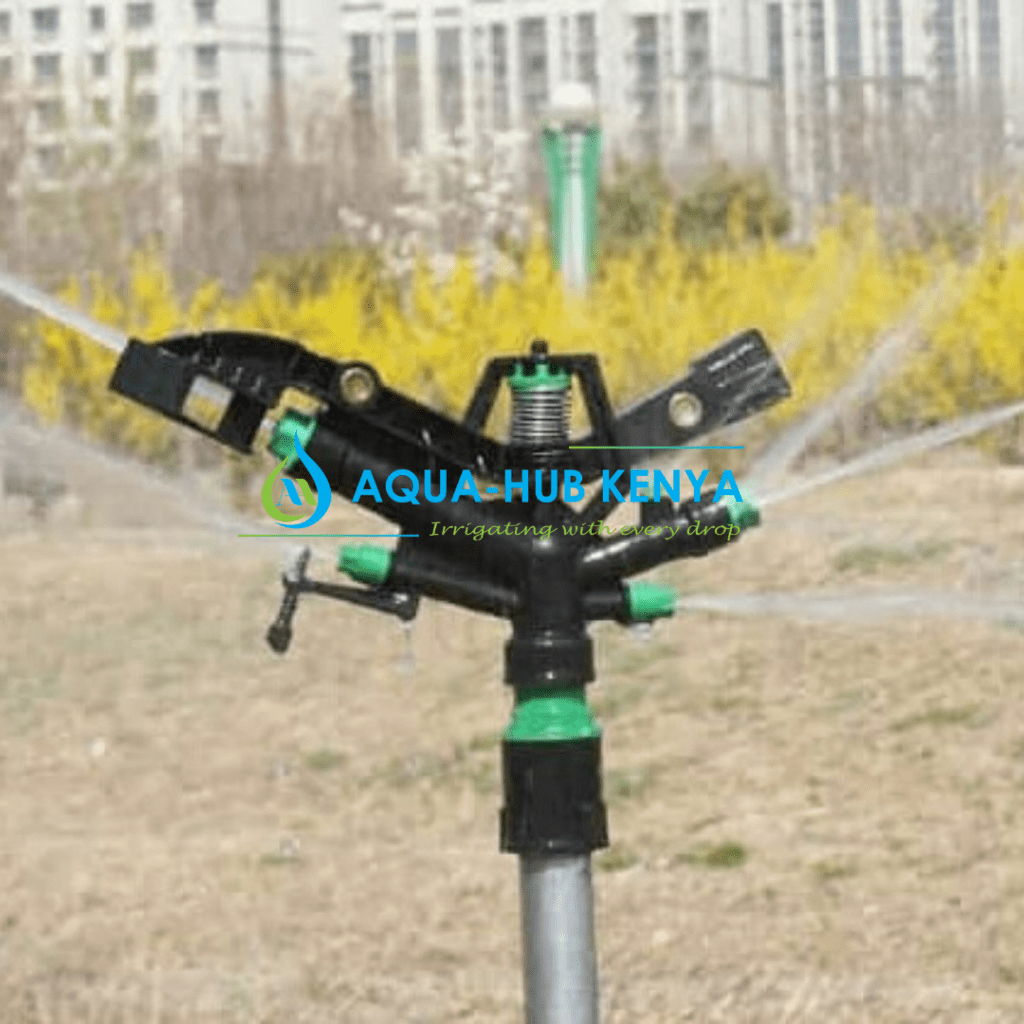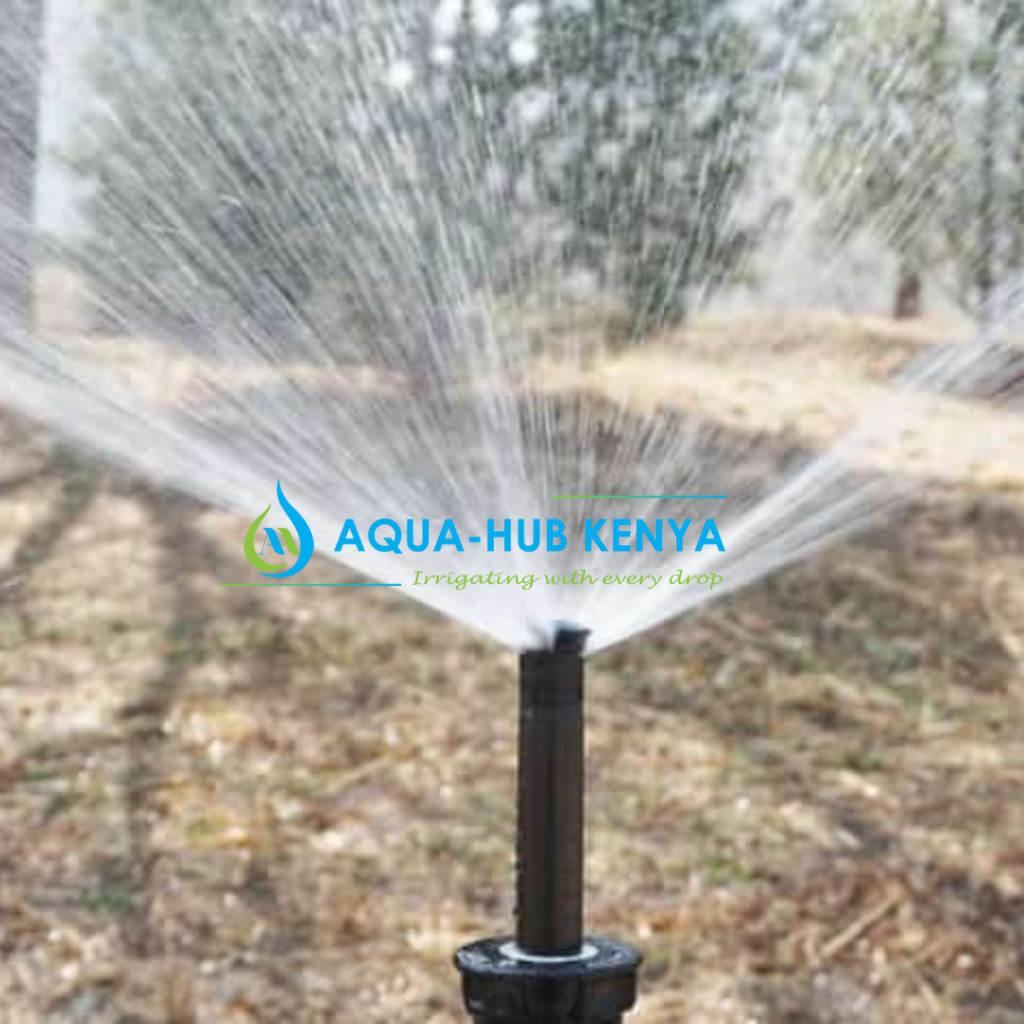Overhead/Sprinkler Irrigation
Overhead sprinkler irrigation is a method of delivering irrigation water similar to rainfall. Pumping water supplies are then used to distribute water through a network of pipes. It is then sprinkled into the air and sprayed throughout the whole soil surface using spray heads. Hence, breaking it into small water drops that fall to the ground.

Irrigation is done by a system of pressure-controlled spray heads and rotors which, then, scatters water. And sophisticated head nozzles are used to split water up into little water droplets, thus disseminated through an effective spray pattern.
Water is routed to one or more central sites inside the field. It is then dispersed by overhead high-pressure sprinklers or guns in sprinkler or overhead irrigation. A solid-set irrigation system is one that uses components such as sprinklers, sprays, or guns that are positioned overhead on permanently installed risers.
Sprinklers are appropriate for use on all sorts of properties. Since they provide effective coverage for small to big areas. Sprinklers come in a variety of discharge capacities. Thus making it adaptable to practically all irrigable soils.
Overhead/Sprinkler Irrigation is ideal for which kind of crops
Sprinkler irrigation is appropriate for the majority of row, field, and tree crops. This is because water can be sprayed over or under the crop canopy. Big sprinklers are not suggested for watering of fragile crops such as lettuce. This is because the large water drops created by the sprinklers might harm the crop.
Overhead Irrigation is ideal for which kind of soil
Sprinklers work best on sandy soils. This is because it is mostly appropriate for soils with high infiltration rates. They may be sometimes used in any soil. The average application rate from the sprinklers (in mm/hour) should be low. Less than the fundamental infiltration rate of the soil. Thus minimizing surface ponding and runoff.
Sprinklers are perfect for soils that are prone to crusting. Light fine sprays should, therefore, be ideal if sprinkler watering is the only option available. You should also avoid bigger sprinklers that produce larger water droplets.
What are the advantages of Sprinkler Irrigation?
Sprinkler irrigation is ideal to water vast areas such as lawns, commercial premises, and athletic sports complexes. Advantages in terms of cost: The flow rate is 60-70 percent lower than that of traditional sprinklers. The pump, pipelines, valves, and other equipment have a reduced initial investment cost. This is because there are no leaks or pipe bursts in the new sprinkler system.
The following are some of the advantages that an overhead sprinkler system may provide:

- The coverage area of the application is greater compared to the traditional ones.
- It is ideal to protect grass seed germination, fertigation, and frost.
- Intervals of irrigation are short (keeping seed wet).
- Reduces maintenance expenditures.
- Modifications to spray patterns are possible.
- It’s both inexpensive and simple to set up.
- It is easier to monitor water than it is to use a surface watering system.
- There will be less interference with farming and less land loss.
- It is possible to apply a high volume of material on a regular basis.
- Mechanization and automation are simple to implement.
- Labor costs are lower.
- It avoids pollution of subsurface water supplies.
- Conserves energy
- Allow usage of plastic components for a long time.
How does Sprinkler Irrigation work?
The basic idea of an overhead watering system is similar to that of a lawn sprinkler. It pumps water in under pressure. Blasted down from flat spray nozzles onto the plants. These can be attached to an overhead network of aluminum pipes or even to the top of a pole.
Since producing an equal coverage may be challenging, some more expensive systems may include a movable overhead boom. The device, which travels throughout the entire crop. And may thus evenly spread the water. The water pistol is another overhead irrigation equipment. As its name implies, it blasts water into the air and out over a field. A huge water cannon may easily cover several acres of ground without the need to reposition it.
Because overhead irrigation systems require a large amount of water at a high pressure. Their complexity and expense vary dramatically depending on the amount of land they cover. Doing irrigation from above makes the foliage moist. If the leaves are moist for a lengthy period of time, anywhere from 10 to 24 hours, fungus and bacterial illness can develop.
What are the major Parts of Sprinkler Irrigation System?
| 1 | Pumping station or Header Assembly | 2 | By-pass valve |
| 3 | Fertilizer tank | 4 | Filtration system |
| 5 | Pressure gauges | 6 | Control valves |
| 7 | HDPE I PVC Pipes | 8 | QRC Pump connector |
| 9 | Sprinkler Nozzles | 10 | Service Saddle |
Which crops benefit from Sprinkler Irrigation System?
| Crops | Water Saving (%) 33 | Yield increase (%) 24 |
| Cotton | 36 | 50 |
| Sorghum | 55 | 34 |
| Maize | 41 | 36 |
| Onion | 33 | 23 |
| Sunflower | 33 | 20 |
| Wheat | 35 | 24 |
